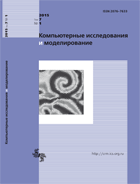All issues
- 2025 Vol. 17
- 2024 Vol. 16
- 2023 Vol. 15
- 2022 Vol. 14
- 2021 Vol. 13
- 2020 Vol. 12
- 2019 Vol. 11
- 2018 Vol. 10
- 2017 Vol. 9
- 2016 Vol. 8
- 2015 Vol. 7
- 2014 Vol. 6
- 2013 Vol. 5
- 2012 Vol. 4
- 2011 Vol. 3
- 2010 Vol. 2
- 2009 Vol. 1
Discrete-element simulation of a spherical projectile penetration into a massive obstacle
А discrete element model is applied to the problem of a spherical projectile penetration into a massive obstacle. According to the model both indenter and obstacle are described by a set of densely packed particles. To model the interaction between the particles the two-parameter Lennard–Jones potential is used. Computer implementation of the model has been carried out using parallelism on GPUs, which resulted in high spatial — temporal resolution. Based on the comparison of the results of numerical simulation with experimental data the binding energy has been identified as a function of the dynamic hardness of materials. It is shown that the use of this approach allows to accurately describe the penetration process in the range of projectile velocities 500–2500 m/c.
Copyright © 2015 Abgaryan K.K., Zhuravlev A.A., Zagordan N.L., Reviznikov D.L.
- , , , . High-speed penetration. Discrete-element simulation and experiments. // Computer Research and Modeling. — 2017. — V. 9, no. 6. — P. 937. DOI: 10.20537/2076-7633-2017-9-6-937-944
Indexed in Scopus
Full-text version of the journal is also available on the web site of the scientific electronic library eLIBRARY.RU
The journal is included in the Russian Science Citation Index
The journal is included in the RSCI
International Interdisciplinary Conference "Mathematics. Computing. Education"







